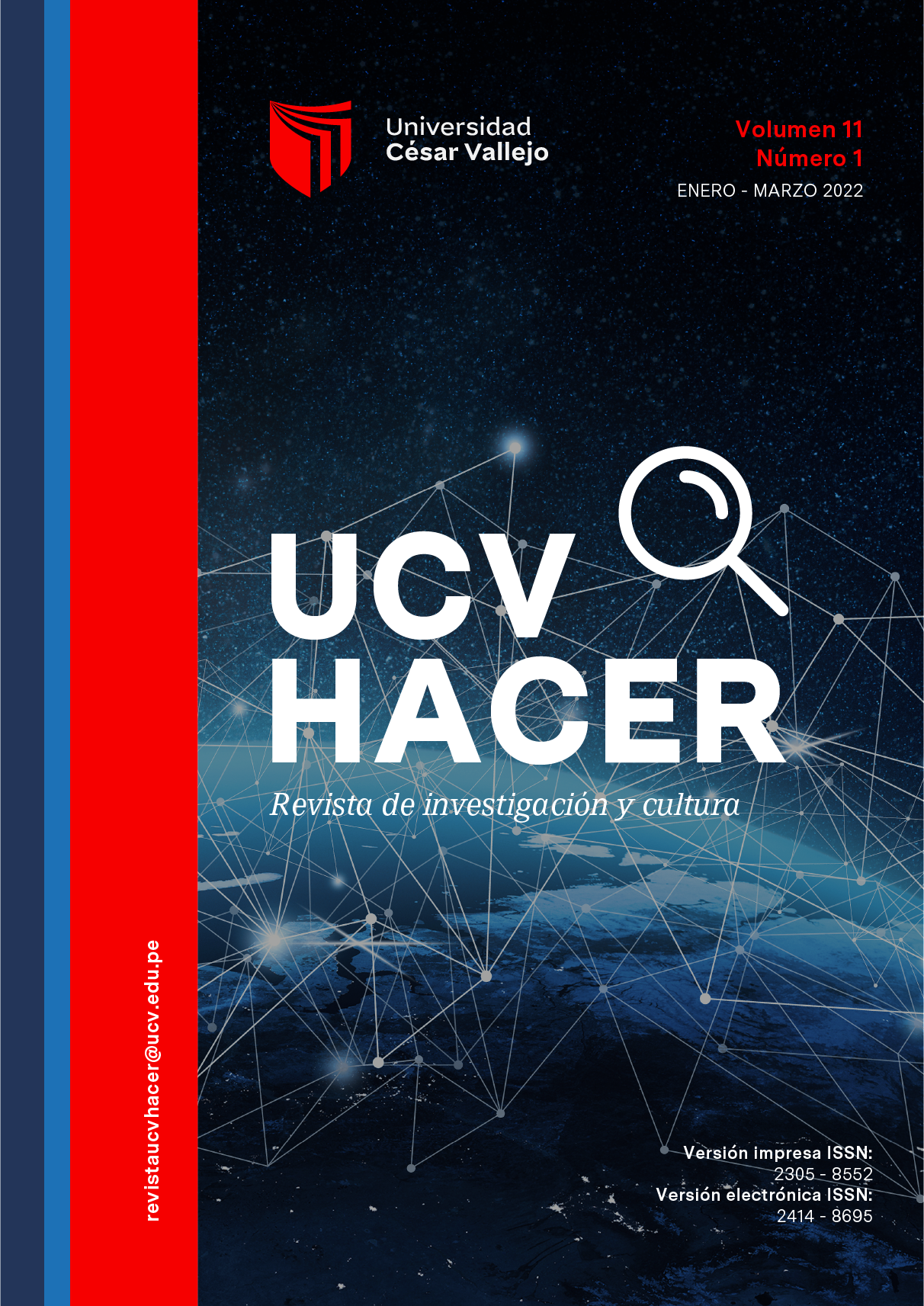Social imaginaries about the impact of the Ecuador—Peru binational tourism route
DOI:
https://doi.org/10.18050/RevUCVHACER.v11n1a9Keywords:
Desarrollo comunitario, Desarrollo económico, Desarrollo sostenible, Desarrollo rural, Desarrollo rural integrado, TurismoAbstract
The Mangahurco (Ecuador) - Casitas (Peru) binational tourism route is a project that has been developed between 2015 and 2021, and responds to the interest of promoting sustainable development in the border area. This work analyses the social imaginaries or perceptions of the inhabitants about economic development and ecotourism in these rural communities. The approach was quantitative, with a non-experimental and cross-sectional design, at a descriptive-explanatory level. The variables analysed were: a) economic development and, b) ecotourism development. A questionnaire with an ordinal scale administered through the Google form platform was used. A pilot test yielded an Alpha of 0.96. The population consisted of two groups: 144 inhabitants of Casitas - Peru, and 144 inhabitants of Mangahurco. The sampling process was non-probabilistic and purposive. Frequency, median and range were calculated. For comparison, the U-Mann Whitney – Wilcoxon test was used for independent simples (G1: Casitas, Peru; G2: Mangahurco, Ecuador). The general hypothesis was that there was a positive impact of the project on the development of rural communities. The results from the similar perceptions of both communities (U-Test > 0.05) do not fully confirm this assertion. It is evident that the communities have not improved their development indicators despite the investment made. A slight positive influence of the tourist route on ecotourism development was evident. This highlights the potential and hope for ecotourism as a development alternative.
Keywords: Community development, economic development, sustainable development, rural development,
integrated rural development, tourism.
Downloads
References
Boyra, J. (2007). Turismo y Desarrollo: los términos de una dialéctica. Desafíos y compromisos del turismo: hacia una visión más humana. Congreso UNIJES. Bilbao: Universidad de Deusto, 177-203.
Bojanic, D. C. y Lo, M. (2016). A comparison of the moderating effect of tourism reliance on the economic development for islands and other countries. Tourism Management, 53(C), 207-214. https://doi.org/10.1016/j.tourman.2015.10.006
Cañero, P. M., Moral, S., Orgaz, F. y Jimber, J. A. (2017). Análisis de las facilidades del turismo fronterizo y su relación con la satisfacción del turista. Revista de Economía del Caribe, 19, 79-102. http://www.scielo.org.co/scielo.php?script=sci_abstract&pid=S2011-21062017000100079&lng=en&nrm=iso&tlng=es
Caro-González, F. J., Acosta, J. A., Orgaz-Agüera, F. y Castellanos-Verdugo, M. (2015). Turismo, desarrollo sostenible y percepción de los stakeholders. Un estudio de caso en República Dominicana. Revista de Economía del Caribe, 15, 153-182. http://www.scielo.org.co/scielo.php?script=sci_arttext&pid=S2011-21062015000100006&lng=pt&nrm=iso
Cottrell, S.P., Vaske, J.J. y Roemer, J.M. (2013). Resident satisfaction with sustainable tourism: The case of Frankenwald Nature Park, Germany. Tourism Management Perspectives, 8, 42-48. https://doi.org/10.1016/j.tmp.2013.05.005
Flores, O. L., Morales, D. y Moreno, F. (2019). Evaluación del potencial turístico de una ciudad ubicada en la Cuenca de Burgos, Tamaulipas. TURYDES: Revista sobre Turismo y Desarrollo local sostenible, 12(27), 1-15. https://dialnet.unirioja.es/servlet/articulo?codigo=7746123
García, A., Serrano, M. A., Méndez-Méndez, A. y Salinas, E. (2019). Diseño y aplicación de indicadores de calidad paisajística para la evaluación de atractivos turísticos en áreas rurales. Revista de geografía Norte Grande, 72, 55-73. http://dx.doi.org/10.4067/S0718-34022019000100055
González Hernández, M. M., Ledesma, J. de L. y Boza Chirino, J. (2020). Turismo y desarrollo: Una relación compleja. Estudios y Perspectivas en Turismo, 29(4), 1017-1027. https://www.estudiosenturismo.com.ar/PDF/V29/N04/v29n4.pdf
Hernández, R., Fernández, C. y Baptista, P. (2014). Metodología de la investigación (6.a ed.). McGraw-Hill.
Lee, T.H. (2013). Influence analysis of community resident support for sustainable tourism development. Tourism Management, 34, 37-46. https://doi.org/10.1016/j.tourman.2012.03.007
Lemoine, F. A., Castellanos, G. M., Hernández, N. R., Zambrano, S. E. y Carvajal, G. V. (2018). Análisis de los atractivos y recursos turísticos del cantón San Vicente, Ecuador. Retos de la Dirección, 12(2), 133-148. http://scielo.sld.cu/scielo.php?script=sci_abstract&pid=S2306-91552018000200007&lng=es&nrm=iso&tlng=en
López-Guzmán, T., Orgaz-Agüera, F., Alector, M. y Domínguez Estrada, J. F. (2016). Turismo all-inclusive en República Dominicana. Un análisis desde la perspectiva de la demanda turística. Revista de Economía del Caribe, 17, 125-142. https://doi.org/10.14482/ecoca.17.7158
Maldonado-Erazo, C. P., Viñan-Merecí, C., Ludeña-Reyes, A. y Álvarez-García, J. (2018). El turismo rural en un contexto binacional. Caso de estudio: Ruta turística Mangahurco-casitas. International Journal of Professional Business Review, 3(2), 231-252. https://doi.org/10.26668/businessreview/2018.v3i2.77
Martínez Quintana, V. (2017). El turismo de naturaleza: Un producto turístico sostenible. Arbor, 193(785), a396-a396. https://doi.org/10.3989/arbor.2017.785n3002
Moral, S. y Valverde, J. M. (2018). Impactos socioculturales del turismo: Una aplicación al turismo fronterizo. Revista Contribuciones a las Ciencias Sociales (noviembre 2018). https://www.eumed.net/rev/cccss/2018/11/impactos-socioculturales-turismo.html
Orgaz-Aguera, F. y Cañero, P. (2016). E coturismo en comunidades rurales: Análisis de los impactos negativos para la población local. Un estudio de caso. Revesco: Revista de estudios cooperativos, 120, 99-120. https://doi.org/10.5209/rev_REVE.2016.v120.49155
Pachas-Fuentes, M. O. y Alberca-Sialer, F. A. (2021). Evaluación económica de una propuesta para el mejoramiento del acondicionamiento turístico del Santuario de la Melchorita, Ica, Perú. Clío América, 15(29), Article 29. https://doi.org/10.21676/23897848.4180
Rahmani, M., Hajari, B., Karimian, T. y Hajilo, M. (2013). Rural Tourism Development Strategies Using SWOT analysis: Case study. Life Science Journal, 10(4), 395-403. http://www.lifesciencesite.com/lsj/life1004s/060_16734life1004s_395_403.pdf
Quispe, U. (2015). Fundamentos de Estadística Básica (5.a ed.). Lima: Editorial San Marcos.
Sancho, A. y Buhalis, D. (dirs.) (1998). Introducción al turismo. Madrid: Organización Mundial del Turismo. https://asesoresenturismoperu.files.wordpress.com/2016/03/81-introduccionalturismo_omt.pdf
Valle, F. R. (2020). Potencial de los recursos turísticos como oportunidad de recuperación económica en la región Apurímac, Perú, frente al Covid-19. Ciencia Latina Revista Científica Multidisciplinar, 4(2), 298-323. https://doi.org/10.37811/cl_rcm.v4i2.79
Vallejo, J. B., Malla, F. Y., Lalangui, M. S. y Ochoa, J. M. (2020). El impacto económico del turismo en la Provincia de Loja, Ecuador. Evaluación histórica y prospectiva. ECA Sinergia, 11(1), 113-121. https://doi.org/10.33936/eca_sinergia.v11i1.1962
Zarazúa, J.-A., Mazabel, D., Moncayo-Estrada, R. y Rendón-Medel, R. (2015). Evaluación de la sustentabilidad en espacios rurales relacionados con el ecoturismo. Estudio de caso en la selva Lacandona, Chiapas, México. Revista Luna Azul, 40, 47-68. https://www.redalyc.org/articulo.oa?id=321733015005
Downloads
Published
How to Cite
Issue
Section
License
Copyright (c) 2022 UCV Hacer

This work is licensed under a Creative Commons Attribution-NonCommercial-ShareAlike 4.0 International License.










